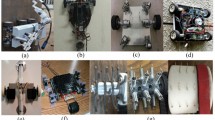Abstract
For service robots coexisting with humans, both safety and working efficiency are very important. In order for robots to avoid collisions with surrounding obstacles, the robots must recognize obstacles around them. In dynamic environments, not only currently moving obstacles but also movable obstacles should be recognized. In this paper, three types of obstacles, such as stationary, movable and moving, are defined, and a method to identify the type of obstacles is proposed. The experiments using a mobile robot were conducted to evaluate the usefulness of the method.
Similar content being viewed by others
References
Nair D, Aggarwal JK (1998) Moving obstacle detection from a navigating robot. IEEE Trans Robotics Autom 14(3): 404–416
Kluge B, Köhler C, Prassler E (2001) Fast and robust tracking of multiple moving objects with a laser range finder. In: Proceedings of the IEEE international conference on robotics and automation, pp 1683–1688
Montemerlo M, Thrun S, Whitaker W (2002) Conditional particle filters for simultaneous mobile robot localization and people- tracking. In: Proceedings of the IEEE international conference on robotics and automation, pp 695–701
Kise M, Zhang Q, Noguchi N (2005) An obstacle identification algorithm for a laser range finder-based obstacle detector. Trans Am Soc Agric Eng 48(3): 1269–1278
Bellotto N, Hu H (2007) People tracking and identification with a mobile robot. In: Proceedings of the IEEE international conference on mechatronics and automation, pp 3565–3570
Wang C-C, Thorpe C (2002) Simultaneous localization and mapping with detection and tracking of moving objects. In: Proceedings of the IEEE international conference on robotics and automation, pp 2918–2924
Hähnel D, Triebel R, Burgard W, Thrun S (2003) Map building with mobile robots in dynamic environments. In: Proceedings of the IEEE international conference on robotics and automation, pp 1557–1562
Wolf D, Sukhatme GS (2004) Online simultaneous localization and mapping in dynamic environments. In: Proceedings of the IEEE international conference on robotics and automation, pp 1301–1307
Laugier C, Vasquez D, Yguei M, Fraichard T, Aycard O (2008) Geometric and Bayesian models for safe navigation in dynamic environments. Intell Service Robotics 1: 51–72
Besl PJ, McKay ND (1992) A method for registration of 3-D shapes. IEEE Trans Pattern Anal Mach Intell 14(2): 239–256
Asama H, Sato M, Bogoni L, Kaetsu H, Matsumoto A, Endo I (1995) Development of an omni-directional mobile robot with 3 dof decoupling drive mechanism. In: Proceedings of the IEEE international conference on robotics and automation, pp 1925–1930
Chung W, Kim S, Choi M, Choi J, Kim H, Moon C-b, Song J-B (2009) Safe navigation of a mobile robot considering visibility of environment. IEEE Trans Ind Electron 56(10): 3941–3950
Author information
Authors and Affiliations
Corresponding author
Rights and permissions
About this article
Cite this article
Tamura, Y., Murai, Y., Murakami, H. et al. Identification of types of obstacles for mobile robots. Intel Serv Robotics 4, 99–105 (2011). https://doi.org/10.1007/s11370-010-0073-4
Received:
Accepted:
Published:
Issue Date:
DOI: https://doi.org/10.1007/s11370-010-0073-4




